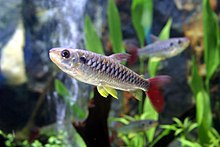bio.wikisort.org - Animal
Chalceidae, the tucanfishes,[1][2] is a family of freshwater fish first described by Henry Weed Fowler in the year 1958. It is a monotypic family, home only to the genus incertae sedis Chalceus.
| Chalceidae | |
|---|---|
 | |
| Chalceus macrolepidotus | |
| Scientific classification | |
| Kingdom: | Animalia |
| Phylum: | Chordata |
| Class: | Actinopterygii |
| Order: | Characiformes |
| Family: | Chalceidae Fowler, 1958 |
All members of the family inhabit areas of northern South America, including the Amazon River and various tributaries.[3]
Classification
Chalceidae is in the order Characiformes. The genus Chalceus used to be placed in the family Characidae, and is still listed there by several sources (like GBIF and ITIS).[4] Research since its original placement suggested movement into the family Chalceidae, based upon phylogenetic significance as a monophyletic group.[5] Morphological features further support this move.[6] This was also done in order to keep the family Characidae monophyletic.[5]
Currently, only Chalceus is classified in Chalceidae. Because Chalceus is a genus with five extant species, Chalceidae has five extant species by extension.[7][8] In alphabetical order, they are:
- Chalceus epakros Zanata & Toledo-Piza, 2004
- Chalceus erythrurus Cope, 1870 (tucan fish)
- Chalceus guaporensis Zanata & Toledo-Piza, 2004
- Chalceus macrolepidotus Cuvier, 1818 (pinktail chalceus)
- Chalceus spilogyros Zanata & Toledo-Piza, 2004
History

Chalceidae was first described in 1958 by Henry Weed Fowler as Chalceidi.[9] It has also been described as Plethodectidi by the same;[10] this is because Plethodectes erythrurus (Cope, 1870) used to be the sole representative, a name now synonymized with Chalceus erythrurus.[11][12] Therefore, the family Plethodectidi became defunct alongside the genus Plethodectes (in the context of describing species of Chalceus).
Etymology
"Tucanfish" directly translates to "toucan fish", because "tucán" means toucan in Spanish.[13] The species C. erythrurus shares a name with the family it belongs to - it is also commonly called the tucan fish.[14]
The sole genus of Chalceidae, Chalceus, gives the family its name and therefore its etymological root. Said root is the Greek word chalkos, which means copper;[15][16] this is in reference to the original description of C. macrolepidotus, wherein Georges Cuvier reported that its scales were "sometimes golden" when preserved in alcohol.[2][17]
References
- Froese, Rainer, and Daniel Pauly, eds. (2021). "Chalceidae" in FishBase. December 2021 version.
- Scharpf, Christopher; Lazara, Kenneth J. (15 September 2020). "Order CHARACIFORMES: Families IGUANODECTIDAE, TRIPORTHEIDAE, BRYCONIDAE, CHALCEIDAE and GASTEROPELECIDAE". The ETYFish Project. Retrieved 26 December 2021.
- "COPEPEDIA summary for Chalceidae : T5006059 : Family". www.st.nmfs.noaa.gov. Retrieved 2021-12-26.
- "Chalceus names - Encyclopedia of Life". eol.org. Retrieved 2021-12-26.
- Oliveira, C., Avelino, G.S., Abe, K.T., Mariguela, T.C., Benine, R.C., Orti, G., Vari, R.P., & Correa e Castro, R.M. (2011): Phylogenetic relationships within the speciose family Characidae (Teleostei: Ostariophysi: Characiformes) based on multilocus analysis and extensive ingroup sampling. BMC Evolutionary Biology, 11: 275. doi: 10.1186/1471-2148-11-275
- Cástor Guisande, Patricia Pelayo-Villamil, Manuel Vera, Ana Manjarrés-Hernández, Mónica R. Carvalho, Richard P. Vari, Luz Fernanda Jiménez, Carlos Fernández, Paulino Martínez, Edgar Prieto-Piraquive, Carlos Granado-Lorencio, Santiago R. Duque, "Ecological Factors and Diversification among Neotropical Characiforms", International Journal of Ecology, vol. 2012, Article ID 610419, 20 pages, 2012. https://doi.org/10.1155/2012/610419
- Zanata, A.M.; and M. Toledo-Piza (2004). "Taxonomic revision of the South American fish genus Chalceus Cuvier (Teleostei: Ostariophysi: Characiformes) with the description of three new species". Zoological Journal of the Linnean Society. 140 (11): 103–135. doi:10.1111/j.1096-3642.2004.00090.x.
{{cite journal}}: CS1 maint: uses authors parameter (link) - Fricke, Ron; Eschmeyer, William N.; Fong, Jon D. (2020). "Genera/Species of Fishes by Family/Subfamily". Eschmeyer's Catalog of Fishes. California Academy of Sciences. Retrieved 26 December 2021.
- Fowler, Henry Weed (1958). "Some new taxonomic names of fishlike vertebrates". Notulae Naturae. 310. Retrieved 26 December 2021.
- Van der Laan, R., Eschmeyer, W.N., & Fricke, R. (2014). Family-group names of Recent fishes. Zootaxa, 3882, 1-230.
- Cope, Edward Drinker (1870). "Contribution to the Ichthyology of the Maranon". Proceedings of the American Philosophical Society. 11 (81): 563–564. Retrieved 26 December 2021.
- Cope, Edward Drinker (1872). "On the fishes of the Ambyiacu River". Proceedings of the Academy of Natural Sciences of Philadelphia. 23: 262. Retrieved 26 December 2021.
- "Translation of tucán – Spanish-English dictionary". Cambridge Dictionary. Cambridge University Press. Retrieved 26 December 2021.
- Froese, Rainer; Pauly, Daniel (eds.) (2021). "Chalceus erythrurus" in FishBase. December 2021 version.
- "Glosbe". Copper in Ancient Greek (to 1453). Retrieved 26 December 2021.
- Hackh, Ingo W. D. (1918). "The Romance of the Chemical Elements". American Journal of Pharmacy and the Sciences Supporting Public Health. 90: 490. Retrieved 26 December 2021.
- Cuvier, Georges (1818). "Sur les Poissons du sous-genre Myletes". Mémoires du Muséum d'histoire naturelle. 4: 454. Retrieved 24 December 2021.
Другой контент может иметь иную лицензию. Перед использованием материалов сайта WikiSort.org внимательно изучите правила лицензирования конкретных элементов наполнения сайта.
WikiSort.org - проект по пересортировке и дополнению контента Википедии